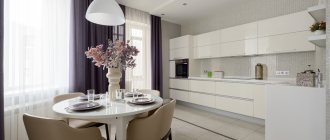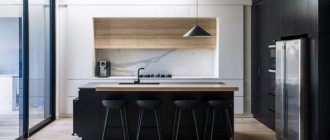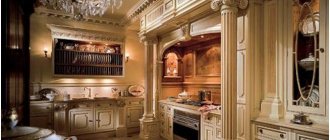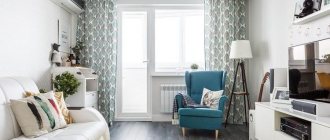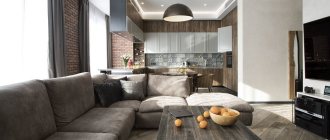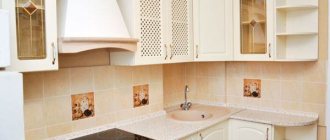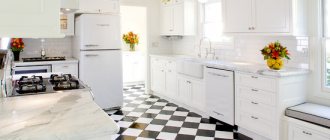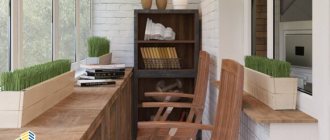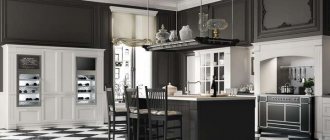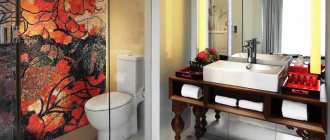Block house - interior decoration and its advantages
Many people do not know what a block house means. In general, this is a simple lining, the main difference of which is that on the front side the surface of the material is finished like a rounded log. Cladding or finishing a house with a block house inside and outside will create the illusion that the building is not built of concrete or brick, but of the highest quality logs.
Despite the fact that this type of finishing material is in many ways reminiscent of lining, it has some distinctive features and associated advantages. First of all, to make a block house, high-quality dried wood with a moisture content of no more than 15% is used. This allows you to protect the boards from rotting, deformation, and fungal damage. True, there is one drawback here - a low level of vapor permeability, and therefore you will have to additionally provide protection from possible condensation.
Another undeniable advantage is the ease of assembly - you can assemble the material without the involvement of specialists, which means finishing the balcony with a block house will cost you several times less. However, when choosing these products as a finishing material, take into account the general appearance of your home and neighboring buildings. For example, a house covered with a block house will look inharmonious next to a brick house. However, the main advantage of this type of lining is that with its help you can easily update the structure without investing a lot of money in reconstruction.
Modern manufacturers produce various sizes of material, but if you are interested in interior lining and block house finishing, then you should choose products with a minimum cross-section. Thanks to this, the living space inside the rooms will not be eaten up, and the material will create a unique relief coating on the walls.
Types for interior decoration
Interior finishing is an operation that one has to deal with when building a house or performing repair work. Of the huge number of technologies and a large selection of building materials, the block house plays one of the key roles in the interior. There are several types of panels used for finishing work inside buildings:
- Wooden. Standard option. Coniferous and deciduous wood is used in production. The thickness of the board is 2-4 cm, so it is necessary to consider options for additional insulation. The cost of a wooden block house is quite high, but it has good sound insulation and is made of environmentally friendly material.
- Vinyl. Used for interior finishing work. This is due to poor resistance to temperature changes, which lead to loss of strength and tarnishing. The panels accurately imitate logs, which allows them to be produced in various colors and create an unusual interior.
- Metal. It has a long service life, which can reach 60 years. It is resistant to temperature changes and does not require processing. Low cost of panels and ease of installation compared to wooden boards.
Block house for interior decoration: what needs to be taken into account?
Before you begin installing the material, you need to study several basic recommendations for selecting products. This will allow you to purchase the most suitable finishing material, because the block house can be different. First, consider the specifics of the building. So, if it was built from natural wood, you need to wait until the building shrinks - this takes about a year.
It makes no sense to carry out finishing immediately after construction, because you will only waste money and time; anyway, the work will have to be done again. It is important to choose the block house wisely based on the type of wood. Thus, most of the products are made from conifers, but such finishing materials will have several characteristic features. For example, at high temperatures, a block house made of conifers will release resin and become very hot. This indicates a small, but still possible possibility of thermal burns.
That is why it is not recommended to use this type of finishing products for baths, steam rooms and saunas - it is best to choose a block house made of linden or aspen. If your choice fell on larch trees, you should remember that ash does not tolerate sudden changes in temperature and high humidity, and therefore it is not suitable for decorating a kitchen and bathroom. By the way, the choice is largely determined by the fact that larch during manufacturing can give up to 10 shades of color, but cedar wood - only up to 7 . A lot depends on what design you choose.
Application in the interior
The front surface of the block house imitates a cylindrical beam. This feature allows you to use it for interior decoration of residential premises - houses and apartments, if you need to get an original interior that is unlike any other.
The small thickness of the blocks does not “steal” the usable area of the house. For spacious rooms, a block house with a width of 120 millimeters is produced - these dimensions allow you to imitate the structure of a real log house inside the house.
There are two ways to decorate the interior of a block house:
- use for continuous interior decoration;
- use for fragmented interior decoration.
The latter method allows you to get an interesting effect, especially if you decorate the wall of the bedroom with “logs”, to which the head of the bed is moved.
The remaining walls are made smooth: plasterboard or plastered. This technique allows you to avoid monotony and introduce natural motifs into the interior.
A block house can be combined with lining - this not only allows you to create interesting interiors in terms of design, but also reduces the cost of interior decoration, because lining is cheaper than “logs”.
The combination of surfaces in the interior, covered with a block house, plastered with decorative plaster and lined with natural stone, allows you to forget about redecorating the house for a long time.
All these materials will last for decades without deteriorating their decorative qualities.
Using a block house, you can give a country house the appearance of a boyar's estate from the time of Ivan the Terrible, a hunting lodge, a fairy-tale hut, a peasant or merchant's house.
It is not necessary to stick to antiquity or rural motifs. Think a little, and you will definitely have ideas on how to fit log surfaces into a modern-style interior.
The interior decoration of a block house painted with light paint will help create a shabby chic style. For country, rustic and ethnic interiors, wood of any shades is used.
Block house is an extremely expressive material, but at the same time it is universal, as it can be combined with any other finish, including glass, metal and stone.
The photo shows successful combinations of wooden blocks with other finishing options, forged, glass and stone accessories.
It is best to use a block house not only inside, but also outside the house. This design allows you to achieve stylistic unity. The complete decoration of a log house for a country house is perceived much more organically than just the interior or just the exterior decoration.
How to install a block house indoors - step-by-step diagram
Step 1: Material selection and calculation
As we have already said, when finishing indoors, it is advisable to use fairly narrow strips of material that can visually expand the room without taking over the space.
It is also advisable to purchase products from the same batch to avoid discrepancies in the shades of the material. That is why you should correctly calculate the required amount of block house. The calculation is made as follows: calculate the total area of the room where the finishing will take place, subtract the area of windows and doors from it. We divide the resulting figure by the useful area of the lining strip. In order to understand how many planks and corners you will need, you need to calculate how much distance you will need to cover.
Step 2: Preparing the surface and products for installation
Its service life will depend on whether the material takes root in your room.
That is why you need to keep the open package with the lining in the room where the renovation will take place for at least three days. Such measures will prevent deformation of the wood during operation. You can also treat the surface in advance with antifungal and antiseptic drugs. The next step is to seal the frame crowns, if we are talking about a wooden house, as well as removing existing gaps and cracks. By the way, you can use a simple method - to putty the seams and places open to drafts, but this method is not as reliable as using tow.
Step 3: Creating the Sheathing
The main thing is that the lathing for the lining and other materials fulfill its main function - providing a flat surface of the walls and additional insulation (using mineral wool or other materials).
In our case, for the lathing you can use a light galvanized profile, which is most often used for installing drywall, or small bars measuring 30*30 cm. The bars are attached strictly perpendicular to the main strip of material. At the same time, unlike the exterior decoration, only you decide how the stripes of the block house will be located. The main advantages of such profiles are their low price, ease of installation, and the absence of the need for additional processing.
Block house in the interior
There are no fundamental technological differences between the internal lining and the external one. Features of installation in the interior:
1. Cladding must be carried out in a thoroughly ventilated area at warm temperatures.
2. For interior decoration, a board of smaller width is used than for the facade.
Cladding the interior walls with block house will give the room a cheerful, natural look. No additional decorative processing (painting, etc.) is required for the block house.
Finishing technology
The process is divided into a series of sequential actions that must begin immediately after purchasing the material.
Product preparation
To ensure durability of the interior lining, the product must be prepared:
- The parts are unpacked and laid out on a flat surface. It is not allowed to place them vertically. This procedure allows the parts to acclimatize.
- All elements are evaluated: defects are identified, fragments with serious flaws are rejected.
- The material is impregnated with fire retardants and antiseptics. It is recommended to do this before installation, since this way the entire parts can be processed.
- The product is left until completely dry.
If decorative wood stain treatment is planned, it is carried out simultaneously with the application of protective impregnations.
While the products are drying, the sheathing is erected. The frame is necessary to hide defects and curvature of the walls, so all racks are fixed level. A wooden beam is used for work; its preparation must be carried out in advance according to the principle described above. Fixation is carried out using self-tapping screws or corners; the elements are placed vertically in increments of 35 to 55 cm.
Further work begins only after preparation.
Installation of material
Installing a block house is not the most difficult task, but it requires care.
The final stage of finishing is coating the material with varnish or wax. This will give the surface a more beautiful appearance and protect the product from damage.
Despite the apparent lack of variety, there are a great many options for using a block house for various finishing solutions. A competent designer can use the material to implement almost any stylistic option for the interior, from retro to high-tech, from classic to modern.
Block house comes in two main varieties:
- imitation log (rounded profile);
- imitation timber (trapezoidal or rectangular profile).
Features of block house cladding
Often, many questions arise during the work, therefore, in order for the interior decoration of a block house to proceed without delays, it is necessary to deal with some of the nuances from the very beginning.
How to attach a block house
Fixing parts is a fairly simple procedure. Since the material is identical to the lining, the installation principle is the same. Fastening is carried out directly on the wall or sheathing; the elements are connected using a tongue-and-groove locking mechanism. Additionally, self-tapping screws are used, with which the fragments are stitched through.
Fastening panels with clamps is easier than with screws or nails
An alternative method involves hidden fasteners: the parts are fixed using clamps (clips put on from the grooved end and attached to the base with screws). This type of wall decoration is much preferable, since there is no need to hide the screws.
How to make external and internal corner joints
To make the inner corner of the block house attractive, you need to make an effort. You should take care of creating a joint in advance, because some methods involve purchasing additional material.
Methods of internal connection of parts:
Creating outside corners is a simpler procedure. It involves two main options: trimming the joining parts on each side at 45 degrees and using a corner overlay.
